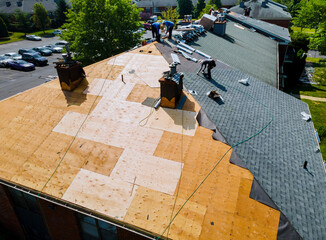Becoming a Roofer
Roofers are responsible for protecting buildings and their contents. A leaking roof can cause damage to walls, ceilings, and even furnishings. Roofers are also responsible for reroofing, which involves replacing an old roof on an existing building with a new one. These professionals use various tools and equipment to complete their work. They also use hammers and caulking guns to fix leaks and prepare surfaces for new roof installations.

People interested in becoming a roofer usually possess traits that make them realistic, independent, and thrifty. They also enjoy physical, athletic, and intellectual tasks. Despite their hard work and dedication, most roofers also have a good sense of humor. In addition, they are realistic and work with their hands, and are often tolerant of other professions that can be more demanding and threatening. A job in this field is not for everyone, though. Some roofers may even enjoy the social and intellectual interaction that comes with working with people in general.
Many roofing jobs require physical labor. This occupation is physically demanding, requiring heavy lifting, bending, and kneeling. Because roofing work is often done outdoors, roofers must be physically fit. However, there are also risks associated with steep roofs and working on scaffolding or ladders. Furthermore, roofers must be flexible and stand, bend, and climb for long periods of time. Finally, because roofing work is seasonal, roofers may work overtime to get the job done as quickly as possible.
Depending on the province or territory in which you live, you may have to go to school to become a roofer. Typically, apprentices learn the trade on the job. However, some apprenticeship programs also require that applicants have a high school diploma. In general, an apprenticeship program consists of at least 2000 hours of on-the-job training and 144 hours of classroom instruction. Apprentices learn basic math, layout work, and proper safety procedures.
Roofers perform all types of roofing work. This includes the installation and repair of roofs. They measure and calculate the number of materials needed for a particular job. Roofing materials are laid down, and helpers set up ladders and hoist materials to the roof. The helpers also help the roofers install new roofs or repair an existing ones. They also clean and clear work areas. You can work as a roofer, or as a roofing contractor in a commercial setting.
Despite the high risk of injuries and low pay, roofers enjoy a great career opportunity. Moreover, the shortage of qualified roofers will continue to be an issue in many parts of the country. Many regions will need roofers in the coming years. However, unlike many other professions, roofing requires no special education. And, most roofers spend most of their day outside, so getting fresh air will improve your mood and performance at work. The best thing about this career is that it doesn’t require much training or education.
As a roofer, you can choose to become self-employed. This option offers more flexibility and independence, but be careful that you don’t get too comfortable with it. Self-employment is not for everyone – there are many downsides to it. But, if you’re not happy in your current job, you can always quit. At the same time, you can always quit a day or two. The upside to this route is that you can work when you want to.
Most residential roofs are covered with shingles. Roofers first lay three-foot strips of roofing felt, and then nail overlapping rows of shingles to the roof. In addition, they measure and cut shingles and felt to fit chimneys and vents. In order to make the joints waterproof, roofers install metal flashing strips over the exposed nail heads to prevent water from leaking in. Lastly, they apply roofing cement to the exposed nail heads to prevent water from penetrating the roof.
When hiring a roofer, make sure you communicate openly and honestly with both parties. Communicating with the contractor will ensure the project’s success. If a roofer is unsure of what you want, make sure to ask questions and clarify any concerns you may have. Then, the roofer can explain the process of replacing your old roof. Make sure to discuss the cost of materials and repair options. Getting quality work from a roofer is an excellent way to avoid a nasty surprise later.
Look for a roofing company that serves the neighborhoods and the surrounding areas. They offer a comprehensive range of services from inspections and roof replacement to caulking, waterproofing, cleaning, and siding installation. In addition to repairing roofs, they also offer 24-hour emergency services and install various types of roofing systems. Some companies even do siding and gutter installation. A roofer will install your roof with materials such as asphalt or vinyl, which is a great choice for your property.



